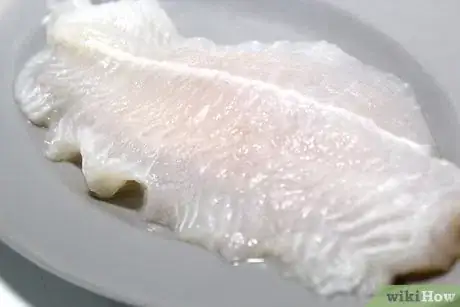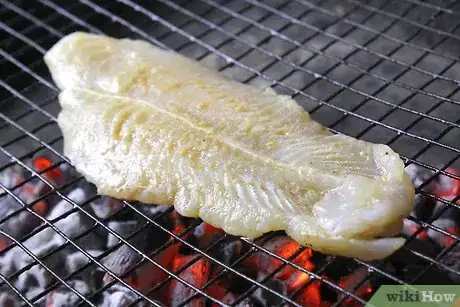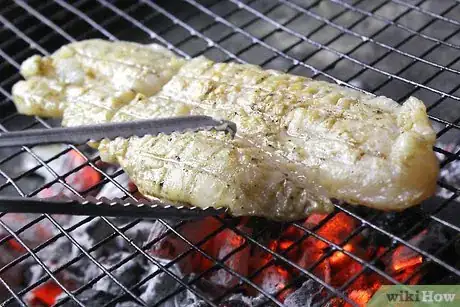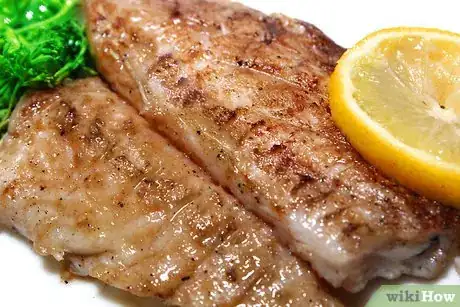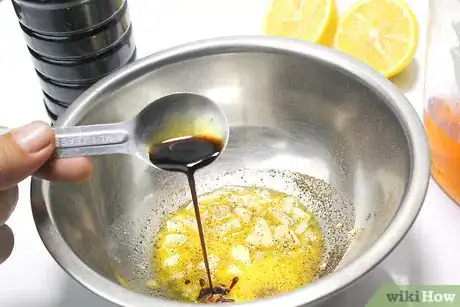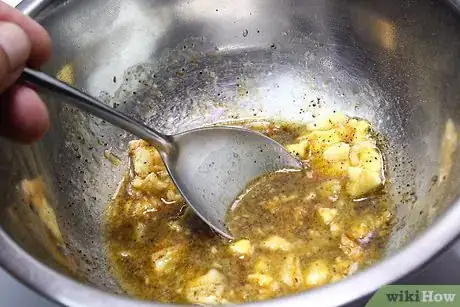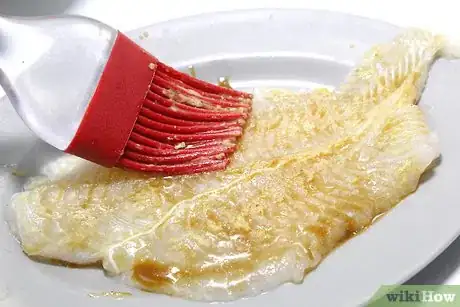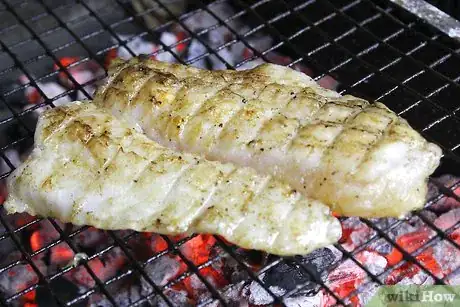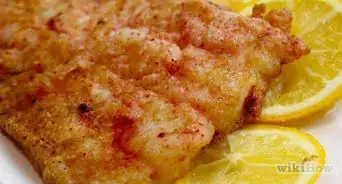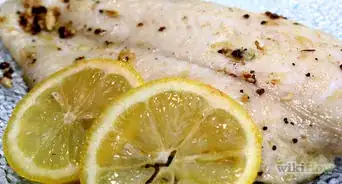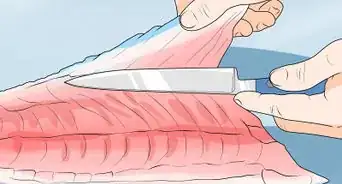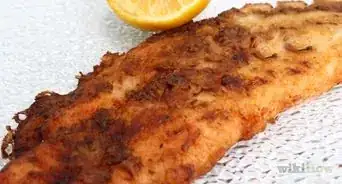This article was co-authored by Jennifer Levasseur. Chef Jennifer Levasseur is a Personal Chef and the Owner of The Happy Cuisiniere based in Breckenridge, Colorado. She has over 12 years of culinary experience and specializes in Mountain and Contemporary Rustic cuisine. Moreover, she can craft dishes and modify menus to accommodate dietary restrictions, such as gluten-free, vegetarian, vegan, pescatarian, and dairy-free diets. In addition to a Bachelor’s degree in Marketing and Management from the University of Houston, Chef Jennifer holds Associate’s degrees in Culinary Arts and Baking & Pastry Arts from Houston Community College.
This article has been viewed 163,073 times.
Halibut is a popular cooking fish because of its dense texture, mild flavour, and low-fat content. Grilling is a great way to cook halibut because it brings out the sweet flavours of the white fish meat. Cover the halibut with a marinade to add extra flavour to the fish and then grill each side of the halibut for 5 minutes. Serve the fish with lemon wedges and your favourite vegetables. Enjoy!
Ingredients
Honey and Lemon Marinade
- 2 tablespoons (28.5 grams) of melted butter
- 2 tablespoons (42.5 grams) of honey
- The juice from ½ a medium-sized lemon
- 2 teaspoons (11 grams) of soy sauce
- 1/2 teaspoon (1.1 grams) of pepper
- 2 cloves garlic minced
- 1 pound (0.45 kilograms) fresh halibut filet
- Lemon wedges (for serving)
Serves 4
Steps
Cooking Halibut on the Grill
-
1Preheat the grill to 400 °F (204 °C). Turn the grill on so that it is ready to go once the halibut is prepared. Most grills take 10-15 minutes to heat up.[1]
- Make sure that the grate on the grill is clean before you turn it on. It’s much easier and safer to clean it when it’s cold!
-
2Remove the skin from the halibut if you prefer skinless fish. Halibut skin is edible and becomes nice and crispy when it is grilled. However, if you prefer to eat halibut without skin, use a sharp knife to remove the skin from the flesh of the fish.[2]
- A fillet knife works best for removing the skin, however, any sharp knife will do the job.
Advertisement -
3Cover the halibut with a marinade or seasoning. This helps to add flavour to the halibut and makes the outside of the fish crispy. Salt, pepper, and garlic are great seasoning options. Melted butter, lemon juice, and soy sauce are good marinating liquids.[3]
- Experiment with different seasonings and marinades until you find your favourite.
- If you have fresh herbs in your pantry, add these to your seasoning or marinade to give the fish a fresh and earthy flavour.
-
4Place the fillets onto the grill at 400 °F (204 °C) for 5 minutes. Try to spread the fillets out so that they cook evenly. Set a timer to help remind you to check the halibut after 5 minutes. If you can smell the fish burning, turn down the grill.[4]
- Always be careful when cooking on a grill to avoid burns.
-
5Turn the fish fillets over and cook them for another 5 minutes. Use a metal spatula to carefully turn each halibut fillet over. Once again, try to spread the fillets out so that they cook at the same speed. After 5 minutes, insert an instant-read food thermometer into the middle of the halibut and check that it has reached 145 °F (63 °C). This ensures that the fish is safe to eat.[5]
- Continue to cook the halibut until it reaches 145 °F (63 °C).
- Always use metal utensils when cooking on a grill as plastic utensils will melt from the heat.
-
6Transfer the fish to a plate and leave it to rest for 5 minutes. Use a metal spatula to lift the halibut fillets off the grill and onto a plate. Resting the halibut helps to make it tender and full of flavour.[6]
-
7Serve the halibut with lemon wedges and your favourite vegetables. Slice a lemon into wedges and place it beside the halibut on each plate. This can be squeezed onto the fish to add a fresh flavour. Serve the fish with your favourite vegetables, such as potato, carrots, peas, beans, or broccoli.[7]
- Halibut tastes best when eaten hot.
-
8Store the halibut in an airtight container in the fridge for up to 3 days. Transfer the cooked halibut into an airtight container and place it in the fridge. If you want to eat the halibut at a later date, place the airtight container in the freezer for up to 3 months.[8]
- If you don’t have an airtight container, use a sealable bag instead.
- If the halibut has a bad smell or slimy texture after it has been stored, this signals that it has gone off.
Seasoning Halibut with a Marinade
-
1Measure the butter, honey, lemon, soy sauce, pepper, and garlic into a bowl. Measure 2 tablespoons (28.5 grams) of melted butter, 2 tablespoons (42.5 grams) of honey, 2 teaspoons (11 grams) of soy sauce, and 1/2 teaspoon (1.1 grams) of pepper into a small bowl. Add the juice from ½ a medium-sized lemon and 2 cloves of minced garlic.[9]
- If you don’t like garlic, simply leave it out.
- Use manuka honey for maximum health benefits.
-
2Mix the ingredients with a spoon. Continue to mix the ingredients until they are thoroughly combined and the marinade has an even texture. This helps the marinade to have a consistent taste when it is cooked.[10]
- If there are any lumps in the mixture, use the back of the spoon to squash them.
-
3Brush both sides of the halibut fillets with the marinade. Dip a pastry brush into the marinade and paint it over the halibut fillets. Make sure that the entire surface of the fish is covered with the marinade. This helps to make the skin crispy and full of flavour.[11]
- If you don’t have a pastry brush, use a spoon to drizzle the mixture over both sides of the fish instead.
-
4Grill the halibut for 5 minutes on each side. Place the halibut onto the grill for 5 minutes. Use a metal spatula to turn the fish over and cook it for another 5 minutes. Insert an instant-read food thermometer into the middle of the fish and check that it has reached 135 °F (57 °C). This indicates that the halibut is ready to eat. Enjoy![12]
Community Q&A
-
QuestionDo I leave the side with a white fibrous layer on the fillet?
 Community AnswerNo, remove as much as you can; it's stringy and tasteless. Use a sharp paring knife and make an incision under the white layer and then pull the rest off until you have no more white layering.
Community AnswerNo, remove as much as you can; it's stringy and tasteless. Use a sharp paring knife and make an incision under the white layer and then pull the rest off until you have no more white layering.
Things You’ll Need
- Small bowl
- Measuring spoons
- Spoon
- Pastry brush
- Metal spatula
- Knife
References
- ↑ https://www.seriouseats.com/recipes/2012/07/how-to-grill-halibut-fish.html
- ↑ https://www.simplyorganic.com/community/recipe/Seared-Halibut-with-Lemon-Pepper
- ↑ https://www.simplyorganic.com/community/recipe/Seared-Halibut-with-Lemon-Pepper
- ↑ https://www.allrecipes.com/recipe/231537/grilled-halibut/
- ↑ https://www.seriouseats.com/recipes/2012/07/how-to-grill-halibut-fish.html
- ↑ https://www.seriouseats.com/recipes/2012/07/how-to-grill-halibut-fish.html
- ↑ https://www.seriouseats.com/recipes/2012/07/how-to-grill-halibut-fish.html
- ↑ https://www.stilltasty.com/fooditems/index/17372
- ↑ https://thestayathomechef.com/grilled-halibut/
About This Article
To grill halibut, start by preheating your grill to 400 degrees Fahrenheit for 10-15 minutes. While that's preheating, remove the skin from the halibut if you prefer skinless fish, and then apply a marinade or seasoning, like melted butter, lemon juice, garlic, pepper, or soy sauce. Next, when you're done seasoning the fish, place the fillet directly on the grill grate and cook it for 5 minutes on each side or until it reaches an internal temperature of 135 degrees Fahrenheit. Finally, transfer the halibut to a plate and let it rest for 5 minutes before serving. To learn how to make a marinade for halibut, scroll down!

